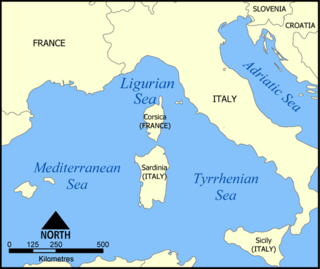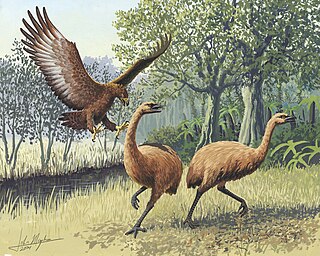Related Research Articles

The Mediterranean Sea is a sea connected to the Atlantic Ocean, surrounded by the Mediterranean Basin and almost completely enclosed by land: on the north by Western and Southern Europe and Anatolia, on the south by North Africa, and on the east by the Levant. Although the sea is sometimes considered a part of the Atlantic Ocean, it is usually referred to as a separate body of water. Geological evidence indicates that around 5.9 million years ago, the Mediterranean was cut off from the Atlantic and was partly or completely desiccated over a period of some 600,000 years during the Messinian salinity crisis before being refilled by the Zanclean flood about 5.3 million years ago.

The Caridea, commonly known as caridean shrimp or true shrimp, are an infraorder of shrimp within the order Decapoda. They are found widely around the world in both fresh and salt water.

The edible frog is a species of common European frog, also known as the common water frog or green frog.

The zebra mussel is a small freshwater mussel. The species was originally native to the lakes of southern Russia and Ukraine, but has been accidentally introduced to numerous other areas and has become an invasive species in many countries worldwide. Since the 1980s, the species has invaded the Great Lakes, Hudson River, and Lake Travis.

The Ligurian Sea is an arm of the Mediterranean Sea, between the Italian Riviera (Liguria) and the island of Corsica. The sea is theorized to be named after the ancient Ligures people.

Clarias is a genus of catfishes of the family Clariidae, the airbreathing catfishes. The name is derived from the Greek chlaros, which means lively, in reference to the ability of the fish to live for a long time out of water.

Calcio Lecco 1912, commonly referred to as Lecco, is an Italian football club based in Lecco, Lombardy. It currently plays in Serie C, having last been in Serie A in 1967.

Island gigantism, or insular gigantism, is a biological phenomenon in which the size of an animal species isolated on an island increases dramatically in comparison to its mainland relatives. Island gigantism is one aspect of the more general "island effect" or "Foster's rule", which posits that when mainland animals colonize islands, small species tend to evolve larger bodies, and large species tend to evolve smaller bodies. Following the arrival of humans and associated introduced predators, many giant as well as other island endemics have become extinct. A similar size increase, as well as increased woodiness, has been observed in some insular plants.

The Soling is an open keelboat that holds the World Sailing "International class" status. The class was used from the 1972 Olympics (Kiel) until the 2000 Olympics (Sydney) as "Open Three Person Keelboat". Besides the Olympic career of the Soling the boat is used for International and local regattas as well as for recreational sailing. The Soling is managed by the International Soling Association under auspician of World Sailing/ISAF/IYRU since 1968.
Cosenza Calcio 1914 was a professional Italian football club based in Cosenza, Calabria.

The western barbastelle, also known as the barbastelle or barbastelle bat, is a European bat in the genus Barbastella. This species is found from Portugal to Azerbaijan and from Sweden to Canary Islands, where a sub-species was identified. It has a short nose, small eyes and wide ears. The conservation status of B. barbastellus is assessed as "Near Threatened", "Vulnerable", "Critically Endangered" or "Extinct" in various parts of its range.

Psephophorus is an extinct genus of sea turtle that lived from the Oligocene to the Pliocene. Its remains have been found in Europe, Africa, North America, and New Zealand. It was first named by Hermann von Meyer in 1847, and contains seven species, P. polygonus, P. calvertensis, P. eocaenus, P. oregonesis, P. californiensis, P. rupeliensis, P. scaldii, and a species discovered in 1995, P. terrypratchetti.

Lithophaga lithophaga, also known as date shell or date mussel, is a species of Bivalvia belonging to the family Mytilidae.

A newt is a salamander in the subfamily Pleurodelinae. The terrestrial juvenile phase is called an eft. Unlike other members of the family Salamandridae, newts are semiaquatic, alternating between aquatic and terrestrial habitats. Not all aquatic salamanders are considered newts, however. More than 100 known species of newts are found in North America, Europe, North Africa and Asia. Newts metamorphose through three distinct developmental life stages: aquatic larva, terrestrial juvenile (eft), and adult. Adult newts have lizard-like bodies and return to the water every year to breed, otherwise living in humid, cover-rich land habitats.
Bobosaurus is an extinct genus of sauropterygian reptile related to plesiosaurs. It is based on the holotype MFSN 27285, a partial skeleton found in Early Carnian-age rocks of the Rio del Lago Formation, northeastern Italy. Bobosaurus was named in 2006 by Fabio M. Dalla Vecchia and the type species is B. forojuliensis. It may be a pistosaurid, or closer to Plesiosauria. A recent cladistic analysis found it to be a pistosaur.

Megadontosuchus is a genus of tomistomine crocodylian from the middle Eocene of Italy. Fossils have been found from Monte Duello in the province of Verona. The genus is currently monotypic, with the type and only species being M. arduini. The species was originally named in 1880, although it was assigned to the genus Crocodilius. The genus was first erected by paleontologist Charles C. Mook in 1955 along with the tomistomine genus Kentisuchus, which was also first classified as Crocodilius. No holotype for Megadontosuchus was designated in 1880, and a lectotype wasn't proposed until 2007.

An anchovy is a small, common forage fish of the family Engraulidae. Most species are found in marine waters, but several will enter brackish water, and some in South America are restricted to fresh water.

Albuneidae is a little-known family of specialized burrowing sand crabs. There are 50 extant species as well as nine fossil species that have been described. Fossil specimens have been described from the Cretaceous, Miocene and Oligocene.
Bechleja is an extinct genus of shrimp which existed during the Eocene period. It contains four species.
Art.52, Norme organizzative interne della FIGC governs the status of phoenix clubs in football in Italy. The article was revised in 2004, 2008, 2010 and 2014.
References
- ↑ Sammy De Grave; N. Dean Pentcheff; Shane T. Ahyong; et al. (2009). "A classification of living and fossil genera of decapod crustaceans" (PDF). Raffles Bulletin of Zoology . Suppl. 21: 1–109. Archived from the original (PDF) on 2011-06-06.
- ↑ Alessandro Garassino; Sergio Bravi (2003). "Palaemon antonellae new species (Crustacea, Decapoda, Caridea) from the lower Cretaceous "Platydolomite" of Profeti (Caserta, Italy)". Journal of Paleontology . 77 (3): 589–592. doi:10.1666/0022-3360(2003)077<0589:PANSCD>2.0.CO;2.